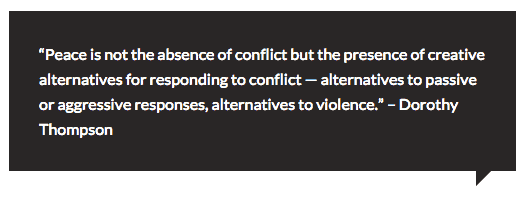Research into team success makes it clear that successful teams need to exhibit the following five behaviors:
Trust in each other
Engage in conflict
Commit to decisions
Hold one another accountable
Focus on achieving collective results
We often think about the “weak links” in today’s team-centered workplace, and here’s what we find. While it seems just about everyone is angry about something, constructive discussions to resolve disagreement and produce better outcomes are not nearly as prevalent as they could or should be.
While earlier workplaces were filled with people who struggled not to say anything at all controversial or that might “rock the boat”; today’s workers are more comfortable with disagreement, are sometimes “direct” — bordering on inappropriate — or so buried in their technology that getting them to engage in any honest exchange around an area of conflict seems beyond their capabilities.
What happened to “rational discourse”? How can one work on strengthening their ability to recognize opportunities for constructive conflict and contribute to the conversation to resolve it productively?
First, realize in business as in life conflict is a given. The successful personal or professional life is always based on strong values and eternal truths, but also a strong propensity to compromise around the great vast majority of situations where there is no one best answer, approach or direction. People incapable of compromise, or have what we call “the disease of certainty” will fail and are alone with their superiority or “rightness”.
Would you rather be successful, happy, productive, useful, constructive, helpful, or RIGHT? If you are not a paid political “expert” let us suggest you skip being RIGHT! Business is not a place for constant certainty. Innovation and taking a chance, as previously discussed in many newsletters and tips, however, is an absolute must. Flexing one’s compromise muscles, thinking outside the lines, and having an attitude of inquiry and openness promotes better conflict resolution and allows for innovation.
Keep a sharper lookout for areas of difference whenever you’re working with others to achieve a common goal. Disagreement often signals that a goal can likely be achieved in more than one way. When disagreement occurs, engage in rational discourse, be open to the ideas of others, and listen actively before you dismiss quickly. Many workplaces have cultures that value strength at the expense of thought. In such environments, quick decisions, forceful comments, and unrealistic demands are often used to replace careful consideration. While slowing down just to slow down is not necessarily the answer, a bit more caution could benefit more workplaces than fast responses.
Be the leader who makes a call and commits to achieving it – of course with the team “on-board”. Make sure you have raised areas of disagreement and looked for ways for everyone to feel that they have contributed. That formula means the negotiation, or the conflict, has been properly resolved. Memorize that and implement it.
Ours is a society that loves to “win”. This update on the classic Getting to Yes is a must read to help gain the skills to handle conflict in a fresh way. Haven’t read the ORIGINAL Getting to Yes? Here’s the original — still classic.
Much keeps appearing about workplace conflict. Here’s a piece that also connects to others. It is direct and practical.
Article credit: Dr. Pat Gill Webber

